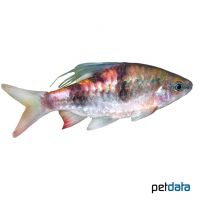Arulius Barb (Dawkinsia arulius)
| Arulius Barb Dawkinsia arulius | |
|---|---|
| Name | Arulius Barb |
| Name Lat. | Dawkinsia arulius |
| Synonym | Puntius arulius |
| Family | Carps |
| Family lat. | Cyprinidae |
| Order | Carps |
| Order lat. | Cypriniformes |
| Origin | Southeast Asia |
| Habitat | Streams, tributaries |
| Diet | Omnivore |
| pH | 6.0-7.5 |
| Behavior | Peaceful |
| Keeping | Group |
| Care Level | Moderate |
| Reproduction | Egg scatterer |
| Breeding | Difficult |
| Life Span | 4-6 years |
| Protection | No |
| Metric Units | |
| Size | 10 cm |
| Temperature | 19-25 °C |
| Hardness | 2-10 °dH |
| Aquarium | ~ 200 l |
| US Units | |
| Size | 4" |
| Temperature | 66-77 °F |
| Hardness | 36-178 ppm |
| Aquarium | ~ 50 gal |
Distribution and habitat
The range of the splendid barb is the river system of the upper Cauvery River in southern India. They live in partly fast flowing tributaries and streams with gravel and stone covered bottoms and dense riparian vegetation.
Maintenance
The aquarium should have a dense border planting, with hiding and retreat possibilities (roots, stones) and offer sufficient swimming space. A dark substrate, some shaded light (floating plants) and a weak current is ideal.
No ammonia, ammonium and nitrite should be detectable, the nitrate value should not exceed 100 mg/l. To ensure the water quality and oxygen content, a filter and heater adapted to the aquarium size is required, as well as lighting for the species-appropriate day-night rhythm of the animals.
Diet
In nature they feed on worms, insects, small crustaceans and detritus. The food offer consists of live food, which is accepted without problems also in frozen form, supplemented with frozen food mixtures. Especially daphnia, artemia and red mosquito larvae must not be missing. In addition, they need regular vegetable food, such as pureed leafy and wild vegetables or dry food (flakes, granules) with high vegetable content (spirulina, kelp)
A regular and varied diet promotes health and increases resistance. Only feed as much as is eaten immediately (in a maximum of 10 minutes).
Behaviour and compatibility
They are peaceful, sociable and lively fish that can be socialized well with other peaceful fish. At least 5, but preferably more, Glaucous Barbs should be kept together.
In principle, only compatible fish species with similar requirements for water conditions and water temperature may be socialized.
Sex dimorphism
In males, the dorsal fin rays are greatly elongated and they have a spawning rash (white dots) around the mouth at spawning time. The females are rounder
Reproduction and breeding
Breeding is difficult and not very productive. They are free spawners and lay eggs in a thicket of fine-leaved plants near the water surface. The fry hatch after 24-48 hours and swim freely after 2-3 days.
Fry must be fed several times a day with special rearing food (Artemia nauplii). In community tanks breeding is hardly possible, because the spawn is easy prey.
Important
Magnificent barbs only develop their colorfulness in the adult stage.
The well-being of the fish should be checked regularly. Temperature should be checked daily, pH, hardness and nitrate levels should be checked at least every 14 days. Regular partial water changes are recommended, even when contaminant levels have not yet reached the upper limit. Sudden changes in water quality should be avoided. Newly introduced fish must be accustomed slowly to the water in the aquarium.
Further literature can be found in your pet store.
References
Text: Sylvia Hos; Image: petdata
Source: BMELV (1998): Tierschutzgutachten - Haltung von Zierfischen (Süßwasser); RIEHL & BAENSCH (2007): Aquarien Atlas Bd. 1, Mergus Verlag; ENGELMANN (2005): Zootierhaltung - Tiere in menschlicher Obhut: Fische, Verlag Harri Deutsch
- Gemäß § 21 Abs. 5 Tierschutzgesetz idgF
